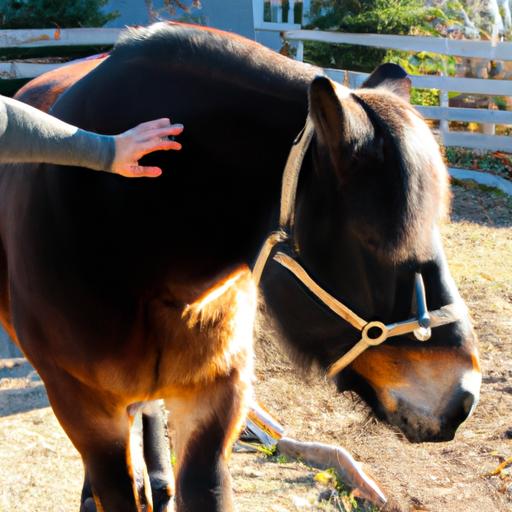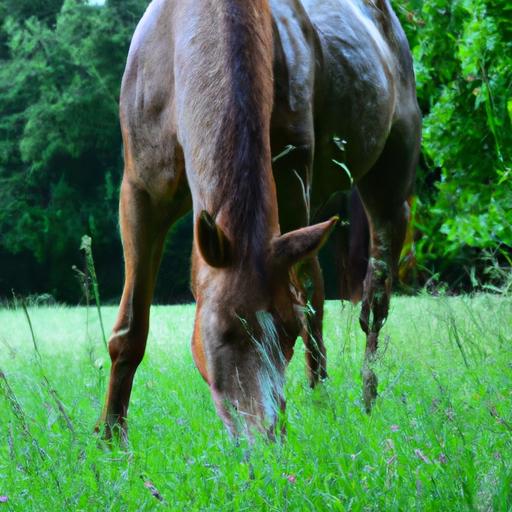Discover how to understand, care for, and rehabilitate blind horses. Explore common behavioral patterns, dietary considerations, and specialized care. Enhance your knowledge of blind horse behavior today!
Introduction

When it comes to our beloved equine companions, understanding their behavior is crucial for their well-being. This holds especially true for blind horses, as their unique circumstances require specialized care and attention. In this article, we will delve into the world of blind horse behavior, exploring the challenges they face and the strategies we can employ to provide them with a fulfilling and safe life.
Definition of Blind Horse Behavior
Blind horse behavior refers to the specific actions, reactions, and emotional responses exhibited by horses who have lost, either partially or completely, their sight. It encompasses their adaptation to their surroundings, their interactions with other horses and humans, as well as their overall quality of life.
Importance of Understanding Blind Horse Behavior for Owners and Caretakers
As owners and caretakers, it is our responsibility to ensure the well-being of our horses. Understanding blind horse behavior is crucial for providing them with a supportive and enriching environment. By comprehending their unique needs, we can implement appropriate strategies to alleviate their anxiety, enhance their confidence, and facilitate their integration into the herd.
Significance of SEO-optimization for Reaching Targeted Audience
While our primary concern is the welfare of these magnificent creatures, it is equally important to share our knowledge and experiences with others. By optimizing this article for search engines, we can reach a wider audience of horse owners, caretakers, and enthusiasts who may be seeking guidance and insights into blind horse behavior. Together, we can create a community that fosters empathy, support, and knowledge exchange.
Join me in the next sections as we explore the causes and types of equine blindness, the emotional and behavioral impact it has on horses, and the strategies we can employ to help blind horses adapt, thrive, and enjoy fulfilling lives. Let’s embark on this enlightening journey to gain a deeper understanding of blind horse behavior and how we can make a positive difference in their lives.
Stay tuned for more insights and practical tips on Horsemasterypro.com, where we are dedicated to enhancing the well-being of horses and fostering a community of knowledgeable and compassionate horse lovers.
Understanding Blindness in Horses
Blindness is a condition that can significantly impact a horse’s life, altering their perception of the world and their interactions within it. To provide the best care for blind horses, it is vital to comprehend the causes, types, symptoms, and emotional implications of equine blindness.
Causes and Types of Equine Blindness
Equine blindness can arise from various causes, including congenital defects, injury, diseases, or age-related degeneration. Some horses may be born blind, while others may progressively lose their vision over time. Common causes of equine blindness include cataracts, glaucoma, uveitis, trauma, and retinal degeneration.
Understanding the specific type of blindness a horse has is essential for tailoring their care. Whether it is total blindness or partial loss of vision, each horse’s needs may differ, and adjustments must be made to ensure their safety and well-being.
Common Symptoms and Indications of Blindness in Horses
Detecting blindness in horses can be challenging, as they often compensate for their loss of vision using their other senses and familiar surroundings. However, certain signs can indicate a horse’s visual impairment. These may include stumbling or tripping over obstacles, hesitancy when moving, bumping into objects, and increased anxiety or spookiness. Additionally, horses may exhibit changes in their behavior or reluctance to perform certain tasks they previously excelled in.
By recognizing these symptoms, horse owners and caretakers can take appropriate measures to support blind horses and alleviate any potential risks or anxieties they may experience.
Emotional and Behavioral Impact of Blindness on Horses
Blindness can have a profound emotional and behavioral impact on horses. The loss of their primary sense can lead to increased anxiety, fear, and stress. Horses may become more reliant on their herdmates, seeking reassurance and guidance from their trusted companions. Additionally, blind horses may exhibit changes in their social dynamics, as their ability to perceive body language and visual cues is compromised.
Understanding the emotional and behavioral challenges faced by blind horses allows us to implement strategies that promote their well-being and help them navigate their environment with confidence and ease. In the upcoming sections, we will explore adaptation and training techniques, as well as effective management and rehabilitation practices tailored specifically for blind horses. Stay tuned for valuable insights to enhance the lives of these remarkable animals.
Adaptation and Training Strategies for Blind Horses
Blind horses may face unique challenges in navigating their surroundings and interacting with their environment. However, with the right strategies in place, we can help them adapt and thrive. Let’s explore some effective approaches to create a safe and comfortable environment, utilize their other senses, and implement progressive training techniques to enhance their confidence.
Creating a Safe and Comfortable Environment for Blind Horses
The first step in supporting blind horses is to ensure their surroundings are safe and conducive to their needs. Remove any potential hazards such as sharp objects or uneven terrain that could pose a risk to them. Additionally, consider implementing tactile markers, such as textured surfaces or different flooring materials, to help them navigate their surroundings more easily.
Providing consistent and predictable routines can also offer a sense of security to blind horses. Keep their environment organized and minimize changes whenever possible. Familiarity can reduce anxiety and promote a more relaxed state of mind.
Utilizing Other Senses for Orientation and Communication
Blind horses rely heavily on their remaining senses, particularly hearing and touch, to navigate their surroundings and communicate with others. Incorporate auditory cues, such as verbal commands or specific sounds, to help them understand and respond to cues from their handlers.
Encouraging social interaction with other horses can also play a vital role in their adaptation. Horses are herd animals, and companionship can provide them with a sense of security and support. Introduce them gradually to compatible equine companions, allowing them to establish bonds and develop a network of trusted relationships.
Implementing Progressive Training Techniques to Enhance Confidence
Training blind horses requires patience, understanding, and a progressive approach. Start with basic groundwork exercises, gradually introducing them to more complex tasks. Use positive reinforcement techniques, rewarding desired behaviors, to build their confidence and motivation.
Consider incorporating tactile cues, such as pressure and release, to guide them during training sessions. This enables them to understand and respond to cues without relying solely on visual signals. Break down tasks into smaller, manageable steps, ensuring they grasp each concept before progressing to the next.
By creating a safe environment, utilizing their other senses effectively, and implementing progressive training techniques, we can empower blind horses to overcome their challenges and lead fulfilling lives. Stay tuned for the next section, where we will explore common behavioral patterns in blind horses and how to address them compassionately and effectively. Keep supporting blind horses on Horsemasterypro.com, your go-to resource for equine care and well-being.
Conclusion
In conclusion, understanding blind horse behavior is essential for providing the best care and support to these remarkable animals. By recognizing the challenges they face and implementing appropriate strategies, we can help blind horses adapt and thrive in their environment.
From managing anxiety and fear-related behaviors to addressing aggression and spookiness, it is crucial to approach each horse as an individual and tailor our techniques to their specific needs. Additionally, understanding social interaction and herd dynamics among blind horses can help us create a harmonious and inclusive environment for them to flourish.
In terms of care and management, dietary considerations play a significant role in ensuring the overall health and well-being of blind horses. Regular veterinary check-ups and specialized care are also vital to address any potential health issues promptly. Furthermore, regular exercise and mental stimulation are essential for keeping blind horses physically active and mentally engaged.
At Horsemasterypro.com, we are dedicated to promoting the welfare of horses and providing valuable resources for horse owners and caretakers. By sharing our knowledge and experiences in understanding and supporting blind horse behavior, we aim to create a community that champions empathy and knowledge exchange.
Remember, every blind horse has the potential to lead a fulfilling and meaningful life with the right care and support. Let us come together as a community to ensure that these magnificent creatures receive the love, attention, and understanding they deserve.
Horsemasterypro.com – Enhancing the well-being of horses, one step at a time.


